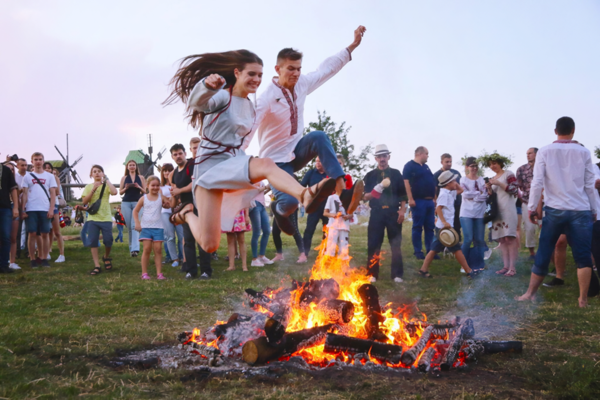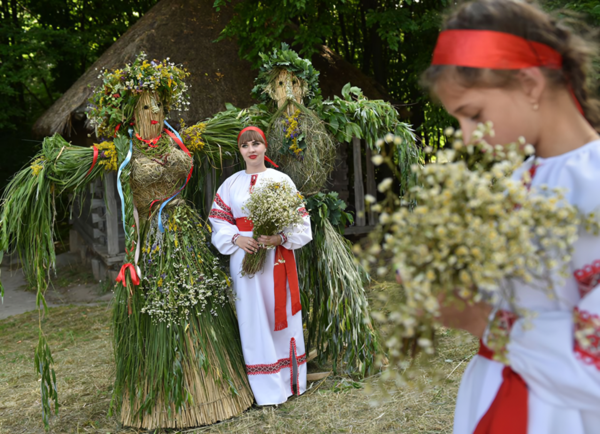Love Over Fire, Prophecy Through Water:
The Ivan Kupala Festival and the Ukrainian Summer

[아츠앤컬쳐] 일 년 중 낮이 가장 긴 밤, 한여름 들판에서 소녀들은 들꽃을 엮어 화관을 만들고, 소년들은 불꽃을 뛰어넘는다. 물과 불, 사랑과 예언, 전통과 현재가 교차하는 축제 ‘이반 쿠팔라’가 열리는 것이다. 이 여름 축제는 기독교의 성 요한의 날과 맞물려 있지만, 그 뿌리는 오래된 슬라브 자연 숭배 전통에 있다. 물과 불, 숲과 꽃, 빛과 어둠은 이 축제의 핵심 상징으로 사람들은 정화와 재생, 사랑과 수확을 기원하며, 공동체와 자연에 자신을 연결한다.
축제의 주인공인 소녀들은 들꽃으로 화관을 만들어 강물에 띄워 보내며 점을 친다. 화관이 물살에 평온히 떠내려가면, 사랑이 가까이 있고, 반대로 화관이 회오리처럼 빙빙 돌거나 금세 가라앉으면, 사랑이 아직 멀거나 어려움이 있을지 모른다는 얘기가 오랜 세월 놀이처럼 전해져 왔다. 이에 소녀들의 손끝에는 늘 진지한 설렘이 묻어난다. 강 건너편의 소년은 마음에 둔 소녀의 화관을 발견하면 물속으로 뛰어들어 그것을 건져낸다. 이렇게 연결된 두 사람이 쌓아 올린 장작 불꽃 위를 손잡고 함께 뛰어넘는 순간, 어떤 장애도 이겨낼 수 있고 그 인연은 영원할 것이라는 믿음이다. 이반 쿠팔라는 단순한 풍습이 아니라, ‘사랑의 용기’와 ‘공동체의 연대’를 확인하는 여름 의식이다.
이 축제에서 또 하나의 중요한 요소는 바로 정화(淨化)다. 불은 악운을 태우고, 물은 새롭게 씻어낸다. 일부 지역에서는 축제 전날 허브와 물로 목욕하고, 풀과 나무에 손을 얹고 건강과 복을 기원하는 의식을 치른다. 불꽃을 넘는 것도 단순한 스릴 넘치는 놀이가 아니라, 지난 한 해의 찌꺼기를 태우고 새롭게 맞이하는 상징적 행위로서 특히 젊은이들은 이 축제를 통해 어른이 된다.

오늘날에도 우크라이나에서는 이반 쿠팔라 축제가 다양하게 재현되고 있다. 리비우, 체르니히우, 이바노프란키우스크 등 서부 지역은 민속 음악과 춤, 화관 워크숍, 손뜨개 공예, 수공예 마켓으로 전통 중심의 축제가 열리고, 키이우 같은 대도시는 현대 음악으로 ‘쿠팔라의 밤 축제’가 열려 젊은 감각으로 재해석되고 있다. 해가 지면 모닥불을 중심으로 모여 춤추고 노래하며, 숲과 호수의 밤은 살아 있는 민속극장이 된다.
흥미로운 점은 이 축제가 지닌 이중성이다. 자연 숭배의 흔적이 뚜렷한 이교적 행위와 함께, 성 요한의 날의 기독교적 요소가 동시에 녹아 있다. 이 둘이 공존하는 이반 쿠팔라는 단순한 민속 축제를 넘어 우크라이나 문화의 다층성과 혼합성을 잘 보여준다. 지금도 낭만적인 옛 풍속에 그치지 않고 축제의 불꽃이 타오르고, 화관은 여전히 강 위를 떠간다. 정화와 예언, 사랑과 용기의 상징은 지금 우크라이나 공동체의 회복을 염원하는 마음으로 재조명되고 있으며, 일부 예술가들은 이 축제를 모티프로 현대적인 설치 작업이나 퍼포먼스를 통해 불꽃을 넘는 용기와 강물 위의 희망을 시각적으로 기록한다. 전쟁의 상처 속에서도 이반 쿠팔라의 불꽃은 꺼지지 않는다. 이 고대 축제를 통해 오늘의 우크라이나가 지켜내고자 하는 가치와 정신이 이어지길 바라는 마음을 느낄 수 있다.

Love Over Fire, Prophecy Through Water:
The Ivan Kupala Festival and the Ukrainian Summer
On the longest night of the year, in the height of the Ukrainian summer, girls weave wildflowers into crowns, and boys leap over bonfires. Fire and water, love and prophecy, tradition and the present moment all converge in one celebration: Ivan Kupala (Івана Купала).
Held every year in early July, near the summer solstice, Ivan Kupala is one of Ukraine’s most vibrant and symbolic folk festivals. While it aligns with the Christian feast day of John the Baptist, its roots trace far deeper into ancient Slavic nature-worship rituals. The core symbols—water and fire, forest and flower, light and shadow—reflect a worldview where purification, renewal, love, and harvest are intimately tied to the natural world. During the festival, people seek to reconnect with both community and nature.
At the heart of the festival are the girls. They gather wildflowers from meadows and fields and craft them into delicate floral crowns. Each crown is then set afloat on a river, becoming a kind of love oracle. If the crown drifts smoothly downstream, it signals the approach of true love. But if it spins in circles or sinks quickly, it may mean that love is distant or obstacles lie ahead. Though passed down as a playful tradition, there is always a quiet seriousness in the hands that release those flower rings into the water.
When a boy spots the crown of the girl he secretly admires, he dives into the river to retrieve it. If successful, the couple then stands together before a bonfire. They hold hands and leap across the flames—a symbolic test of unity and courage. If they can cross the fire together, the belief goes, they will be able to overcome life’s challenges side by side. More than a romantic game, the ritual of Ivan Kupala embodies the values of bravery in love and solidarity in community.
Another essential aspect of the festival is purification. Fire is believed to burn away misfortune; water washes in new life. In some regions, people bathe in herb-infused water the night before the festival and place their hands on trees and grass to pray for health and blessing. Leaping over fire is not just an adrenaline-fueled act—it marks a symbolic farewell to the troubles of the past year and a passage into a new season. For many young people, the night represents a moment of transition into adulthood.

Today, Ivan Kupala is celebrated across Ukraine in both traditional and modern ways. In western cities like Lviv, Chernihiv, and Ivano-Frankivsk, the festival includes folk music, dance, wreath-making workshops, crochet crafts, and artisan markets. In larger cities like Kyiv, the celebration is often blended with electronic music and reimagined as a “Kupala Night Festival” for the younger generation. As the sun sets, people gather around campfires, singing and dancing beneath the stars, and the forests and lakes transform into a living theater of folklore.
What makes this festival particularly fascinating is its duality. It contains strong elements of pre-Christian paganism while also incorporating Christian traditions. Rather than conflicting, these layers coexist, revealing a deep cultural tapestry where multiple identities and worldviews are held together. Ivan Kupala is not just a folk ritual—it is a living reflection of Ukraine’s cultural complexity.
And in today’s Ukraine, this celebration is no longer a romantic relic of the past. Even in the shadow of war, the bonfires of Ivan Kupala still burn, and flower wreaths still drift across rivers. The festival’s messages—of cleansing, prophecy, love, and courage—are being reclaimed as symbols of communal resilience and hope. Some contemporary artists are even drawing on these rituals in installations and performances, capturing the bravery of leaping over fire and the quiet persistence of wreaths floating downstream.
Even amidst the scars of war, the flame of Ivan Kupala has not been extinguished.
Through this ancient celebration of love and purification, we are reminded of the values modern Ukraine seeks to protect—and the spirit it continues to carry forward.

글 ㅣ 박수희
(주)구라파랩 대표
해외브랜드 전시 플랫폼 및 마케팅 컨설팅
해외브랜드 B2B & B2C 전문

